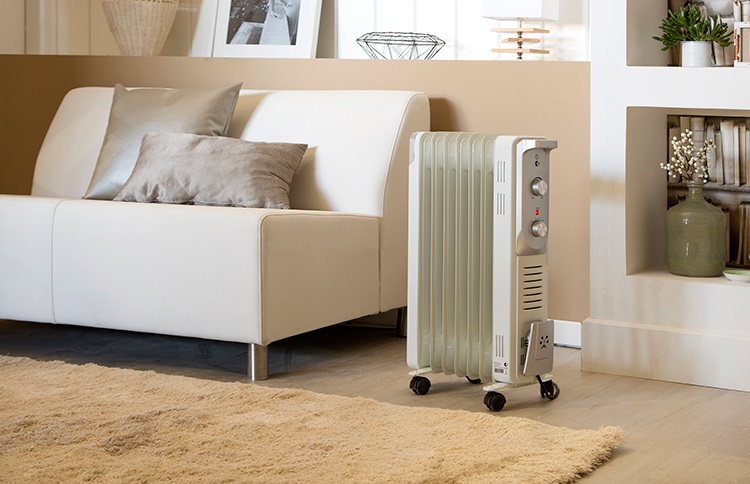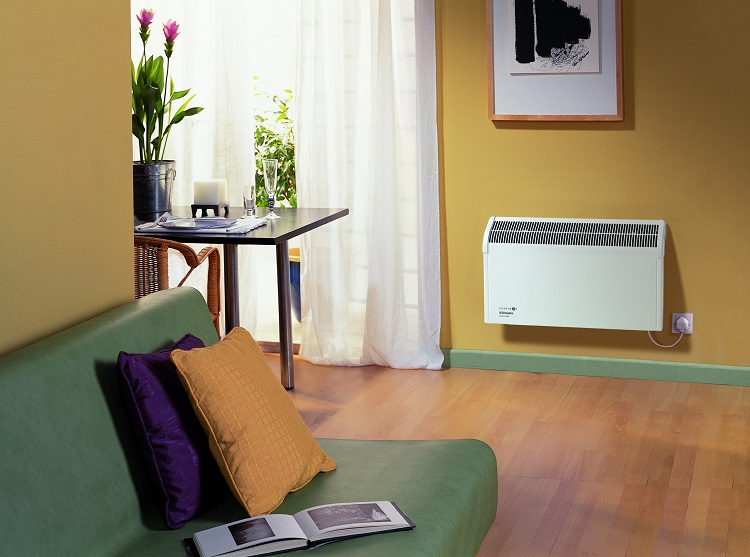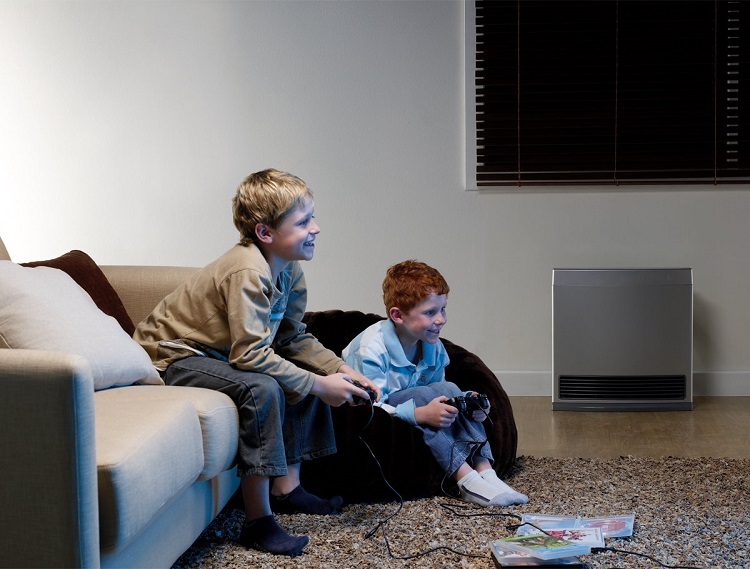A huge selection of mobile devices for heating a home makes buyers wonder what is better in one case or another. The most common heaters are convector-type appliances and filled with mineral oil. When deciding what to buy - a convector or an oil radiator, one should not rely only on their technical parameters. It is necessary to take into account the convenience of using a particular device, its safety for residents of the house (including animals), as well as the rules for caring for it.
Content
Characteristics of oil type heaters
Heating devices are used to control air temperature in a house or apartment. Such mobile devices are most often powered by electricity. Some varieties are equipped with a cooler or convector plates for enhanced air circulation. Others work according to the principle of simple heat transfer from a body heated by a heat carrier.
There are fundamental differences between a convector and an oil cooler. The basis of the device with oil is a metal case with a built-in heating element, powered by electricity (the power cord is plugged into a household outlet). The tank having a heating element is filled with mineral oil, which retains heat well.
Typically, such devices are equipped with a rheostat or temperature controller, as well as a relay to protect against overheating. The surface of the case of most devices warms up to 60 ° C. With a greater heat transfer, protection is needed, this is especially important in a room where there are small children. It can be provided with a decorative screen or grille.
More expensive oil radiators, unlike household convectors, can have additional options and sensors: for example, a device for detecting living objects - when the room is empty, they turn off automatically; the horizontal gauge automatically turns off the overturned appliance.
The advantages of oil devices operating from the network can be listed on the fingers, but they are significant:
- lack of smell of burning dust;
- good heat dissipation;
- quite high performance due to the minimum energy consumption for heating the case;
- air heating occurs from the entire surface of the device (more ribs - higher return);
- a short period of time to warm up to the desired level;
- there is no open source of burning and oxygen consumption;
- mobility (as a rule, this is a lightweight unit on wheels and with handles for carrying);
- affordable price.
An indisputable advantage is their silent operation.
Information for comparison! The efficiency of the oil device is not 100% due to the oil filler, but it remains warm for a long time when turned off. Convectors tend to set in motion warm masses of air. When the power is turned off, this property does not work - the device simply does not heat.
What is important to know about the power of oil heaters
To heat a standard residential bedroom or living room, one network-powered device is enough, whether it be an oil radiator, a fan heater or an electric convector. If you need fast heating of a large room, use the combined method - install 2-3 devices of different types.
Oil coolers vary in power. There are heaters for small rooms (8-12 m²) with heat transfer from 1.0 to 2 kW. More energy-intensive consume from 2 to 2.5 kW, they are designed to heat the air in a room with an area of 18 to 24 m².
Helpful information! The power and number of appliances for a large room with high ceilings is easy to calculate. For this, the parameters specified in the technical description for the model and the volume of air in the room in cubic meters are compared.
To ensure that the room is not hotter than necessary, the heater rheostat is set at the desired level. Having set the required temperature, it turns off automatically. This is very important when saving energy. In expensive models there is a timer that starts according to a certain algorithm, for example, when the owners come home from work.
The oil device does not require special installation, for high-quality heating it only needs to be installed on the legs and placed in any convenient place, but not near objects and furniture.
Characteristics of convector type heaters
Arguing that it is better - a convector or an oil electrical appliance, take into account all aspects, including the shape of the housing and the installation method. Unlike oil appliances, the convector can be floor, built-in and wall. The last two options are ideal for the children's room, when the child needs space on the floor for games.
The convection type portable device has the simplest device - it is a housing with a heating element and a special shape of the external surface with slots to enhance air circulation.
Floor convectors have stable legs, like oil radiators. Floor-mounted devices are almost invisible, their presence can be determined by the neat slots on the floor, from where the warm air flows.
Important! The main difference between the built-in convector and the oil cooler is the possibility of embedding and positioning close to the interior, this is possible due to the low temperature of the case.
It is also often equipped with swivel castors or double casters - for ease of movement. This makes them mobile, even a child or an elderly person can easily move from room to room.
The principle of operation of convection-type heating appliances
The basis of the convectors is the distribution of heat due to the exchange of air masses of different temperature and density. The device operates silently, which differs significantly from a fan heater equipped with an engine with a cooler. The natural convection process quickly warms the air in the room.
When choosing a model, it is worth considering that for wall types it is easier to find a place, but floor-mounted ones are more efficient. The convector's efficiency is greater the lower it is installed: the faster the casting of cold air masses, followed by uniform heating of the room.
Dilute hot air when rising up creates conditions for the influx of heavier cold masses to the heater. The flow of unheated air flows from below - through a slot in the outer casing or through the plates of the housing, and a closed heating element with a diffuser increases its temperature.
Convection heaters radiate heat through the slots of the upper grille or the front panel, in rare cases - on both sides. This is a good way to heat a room without burning oxygen.
Helpful advice! When buying a heater from this category, it is important to clarify the purpose of the convector. There are models for home and office, for industrial and commercial premises, designed for floor installation - for a pool, a large recreation room or a lounge with panoramic windows.
Skirting models are recommended for low window sills, although they are more suitable for equipping non-residential premises. But there is no difference if it is suitable for power and format.
The heat level in the room is easy to adjust by switching the thermostat - you just need to set it to the desired value. It turns on when it gets colder, and disconnects from the network when the desired temperature is reached. Thus, all convectors create a comfortable microclimate in the room.
Convector Advantages
Compared to oil heaters, convectors have more advantages:
- Fireproof devices meet all European requirements.
- They perfectly complement the general heating scheme for combined heating of large areas.
- It is possible to adjust the temperature due to the presence of a relay and a thermostat.
- One powerful appliance is enough to heat a small summer house or studio apartment.
- In a modern apartment or loft apartment, where the standard heating scheme is not used, convectors can be hidden under the steps, in niches or behind the decor, without fear of overheating of building materials and cladding.
- The cost-effectiveness of the device with the options for adjusting the modes helps to save electricity, especially with significant temperature differences in the rooms on the south side.
Comparative analysis of the oil heater and oil convector
When choosing what to buy - a convector or an oil cooler, it is important to compare the operating parameters. What is the difference between the devices can be found in the table.
Table 1
| Characteristics | Oil heater | Household convector |
| Comfort in operation | Sufficient | Tall |
| Heating rate | Middle | Middle |
| Surface temperature | High (dangerous) | Medium (safe), adjustable |
| Lifetime | Sufficient, 5-7 years | High, 8-10 years old |
| Clean and environmentally friendly | Dust does not raise, no burning smell | Fine particles rise into the air |
| Cost-effectiveness | Not very economical (prolonged heating when the radiator is turned on) | Due to the adjustable options, it is approximately 15-25% more economical than other electrical appliances |
| Value for money | Balanced | Large gradation of models in price and adjustment options |
| Weight, format and dimensions | Compact body, medium weight | Small lightweight appliance |
| Accommodation options | Portable radiator on casters, placement only on the floor | Model dependent |
Obviously, a convector is a practical and convenient option. These are more modern units for heating rooms than other types of radiators, powered by an electric network.
Regarding the efficiency of such devices - it is doubtful regardless of the principle of their operation. In any case, if you use the device as the main source of heat, energy costs will be significant.
But if you have to heat a cold room, for example, a cottage or a country house on the weekend, then an oil heater is not the best option. Here the alternative in the form of convectors is a priority - they begin to warm the air masses faster.
Contact with skin, textiles and building materials is safer when using a convector. Its surface is warm, but not scorching, with a close proximity to flammable objects, the probability of fire is minimal.The surface of the heater with an oil filler is much hotter, therefore it is not recommended to install them in a children's room or in a bedroom with infirm people who are not able to disconnect it from the network in an emergency.
The choice also takes into account the power, ease of transfer and installation. Lighter convectors are more convenient in operation and installation, while it is possible to combine wall, floor and floor models.
Comparing the above parameters, it is obvious that each device has its own excellent properties and shortcomings. It makes sense to purchase a convection device, if there is no particular preference in favor of oil heaters.













